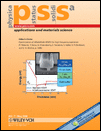Development of native, single crystal AlN substrates for device applications
Abstract
Ultra-low dislocation density aluminum nitride is a very promising substrate for many device structures based on the III–V nitride system. A better lattice and thermal expansion match than foreign substrates such as SiC or sapphire make AlN the substrate of choice for heteroepitaxial growth of AlGaN alloys, especially those with high aluminum concentration. In this paper, we show crystalline and chemical characterization of native aluminum nitride substrates, as well as characterization of AlGaN epilayers with 40 and 50% concentration of aluminum. The observation of atomic steps in atomic force microscope scans of the bare substrates and epilayers, as well as the narrow Full Width at Half Maximum (FWHM) measured on X-ray diffraction, are an indication of both the good surface preparation of the substrates and quality of the epilayers. An estimation of defect density on epilayers grown by Migration Enhanced Metal Organic Chemical Vapour Deposition (MEMOCVD) resulted in mid 106/cm2. (© 2006 WILEY-VCH Verlag GmbH & Co. KGaA, Weinheim)




